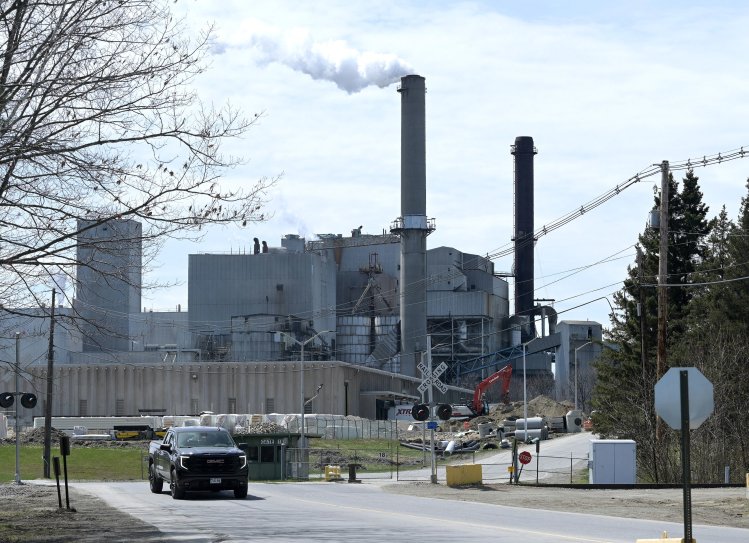RUMFORD — Shredded tires serve as an accessible source of energy for ND Paper’s Rumford mill, but they also help fuel its ranking as one of the nation’s dirtiest industrial polluters, according to a new analysis of air emissions data from the U.S. Environmental Protection Agency.
A report by the Environmental Integrity Project citing EPA’s Toxics Release Inventory data identified ND Paper and Sappi’s Somerset mill in Skowhegan as among the top 100 highest-polluting industrial facilities in the country. Both were flagged for their use of shredded tires as fuel for producing on-site energy.
The EIP is a watchdog group founded by former EPA officials. The nonprofit conducts research and advocacy focused on enforcing environmental laws and reducing industrial pollution.

Burning shredded tires is relatively uncommon, according to EIP’s report — ND Paper and Sappi are among just 36 industrial sites in the U.S. that still maintain the practice. It’s also a controversial practice known for increasing heavy metals and toxic compounds emissions that can pollute air, soil and water, the report shared.
The two mills each reported elevated levels of nitrogen oxides, particulate matter and formaldehyde, all pollutants tied to respiratory illness and environmental degradation. The report links these emissions to the use of tire-derived fuel as well as aging infrastructure — both mills rely on boilers more than 40 years old, which can contribute to inefficient combustion and weak pollution control.
With two of Maine’s largest paper mills landing on EIP’s top 100 list, the state stands out nationally for the size of its industrial emissions footprint relative to its small population, the report said. Despite having few large industrial operations compared to other states, Maine ranked 19th in the country for the total amount of air pollution released by industrial sites in 2022.
While environmental advocates lament the use of tire-derived fuel for energy sourcing, the EPA and Maine Department of Environmental Protection allow the practice as it is considered less harmful than burning coal, another common source for industrial energy. The agencies also monitor the boilers used to fire the fuel and, in ND Paper’s case, the Rumford mill was up to DEP and EPA standards.
“These boilers were first licensed to fire (tire-derived fuel) in 1994,” said David Madore, a spokesperson for the Maine Department of Environmental Protection, “and the addition of TDF resulted in no increases in the emission limits associated with the boilers.”

In Maine, facilities that burn tire-derived fuel must hold a state-issued air emissions license that sets limits on what types of fuel can be used and in what quantity, Madore said.
Today, ND Paper’s two main boilers — massive units known as Cogen Boilers #6 and #7 — are still licensed to burn TDF, along with coal, petroleum coke, wood waste, sludge, natural gas and oil. The boilers are equipped with fixtures that control particulate emissions and reduce sulfur dioxide, Madore said.
“The boilers are designed to combust solid fuels, utilizing a circulating fluidized bed of limestone to control emissions of sulfur dioxide,” Madore said. “This combination of controls is also effective in controlling some regulated hazardous air pollutants.”

ND Paper is required to continuously monitor and report emissions of sulfur dioxide and nitrogen oxides, as well as visible emissions, Madore said. Other pollutants like mercury, hydrochloric acid and carbon monoxide are measured through periodic testing and annual reports.
Records show that ND Paper has reported occasional noncompliance, including failed hydrochloric acid emissions tests in 2017 and periodic “opacity violations” — when visible emissions exceed legal limits. Madore said none of those were directly tied to tire combustion. However, in 2021 ND Paper signed a consent agreement with the state for violations that occurred over the three-year period ending in 2018.
The Rumford mill was in full compliance with its air emissions license as of June 2024, Madore said, adding that a revised draft of ND Paper’s air emissions license was released for public comment in May. DEP expects to finalize it later this month.
Robert Lu, ND Paper’s interim general counsel, defended the mill’s environmental record in a written statement. Lu said the Rumford mill is “proud of its environmental performance” as its boilers emit less than 25% of the permitted pollution limits and that tire-derived fuel is a small amount of a broader fuel mix that includes biomass and black liquor.
“The combustion technology and controls effectively minimize pollutant emissions given a diverse fuel mix,” Lu wrote, adding that the cogeneration boilers “enabled the shutdown of old, antiquated oil-fired boilers and beneficial use of tires for fuel.”
ND Paper has invested tens of millions of dollars in recent years for technology that reduces emissions, Lu said, including $4.5 million in boiler modifications and a $7 million project currently in progress shifting one boiler from oil to natural gas.
Sappi communications manager April Jones told the Maine Monitor this week that the company no longer burns coal and has reduced reliance on other dirty fuels, setting a 2030 deadline to reduce the mill’s 2019 greenhouse gas emissions by 41.5% per ton of product.


We invite you to add your comments. We encourage a thoughtful exchange of ideas and information on this website. By joining the conversation, you are agreeing to our commenting policy and terms of use. More information is found on our FAQs. You can modify your screen name here.
Comments are managed by our staff during regular business hours Monday through Friday as well as limited hours on Saturday and Sunday. Comments held for moderation outside of those hours may take longer to approve.
Join the Conversation
Please sign into your Sun Journal account to participate in conversations below. If you do not have an account, you can register or subscribe. Questions? Please see our FAQs.